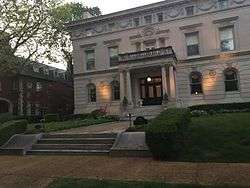William D. Orthwein
William David Orthwein (1841–1925) was a German-born American Civil War veteran and grain merchant in St. Louis, Missouri.
William D. Orthwein | |
|---|---|
| Born | February 9, 1841 |
| Died | 1925 |
| Occupation | Businessman |
| Net worth | US$2 million[1] |
| Spouse(s) | Emily H. Thuemmler |
| Children | Frederick C. Orthwein Percy Orthwein William R. Orthwein |
| Parent(s) | Frederick Charles Orthwein Louise Lidle |
| Relatives | Charles F. Orthwein (brother) William R. Orthwein Jr. (grandson) |
Early life
William David Orthwein was born on February 9, 1841 in Stuttgart, Wurtemberg, Germany.[2][3] His father was Frederick Charles Orthwein and his mother, Louise Lidle. He had a brother, Charles F. Orthwein.[2][4]
Career
Orthwein emigrated to the United States in 1860, arriving in Lincoln, Illinois, to work as a salesman.[2] Two years later, in 1862, he joined his brother in St. Louis, Missouri to work for his grain commission business, Haenshen & Orthwein.[2] Meanwhile, he served in the Union Army during the American Civil War of 1861–1865.[2]
After the war, Orthwein resumed work for Haenshen & Orthwein.[2] By 1870, he worked for his brother's grain shipping firm, Orthwein & Mersman (co-founded by Charles F. Orthwein and Joseph J. Mersman),[4] up until 1879.[2] The firm shipped grains to Europe from St. Louis, via New Orleans, Louisiana and Galveston, Texas.[2] In 1879, it became known as Orthwein Brothers,[4] and it was in business until 1893.[2]
Orthwein founded the William D. Orthwein Grain Company in 1893.[2] It was "the oldest grain firm in St. Louis."[2] He hired his son Frederick to work with him until 1900, when he retired.[2]
Furthermore, Orthwein served as the President of the St. Louis Victoria Flour Mills.[2] He also served as the Vice President of the Manufacturers Railway Company, while Adolphus Busch served as its President.[5] He served on the Boards of Directors of the Mississippi Valley Trust Company and the Kinloch Telephone Company.[2] He also served on the Board of Directors of the St. Louis Merchants Exchange, and he was a member of the St. Louis Chamber of Commerce.[2]
Personal life
Orthwein married Emily H. Thuemmler on June 9, 1870.[2][6] They resided at the Orthwein Mansion at 15 Portland Place in St. Louis, Missouri for 27 years.[6]

Orthwein was a member of the Log Cabin Club and the Union Club, two private members' clubs in St. Louis, Missouri.[2] He donated to the Mullanphy Emigrant Relief Fund.[2]
Death and legacy
Orthwein died in 1925.[1] He was worth US$2 million upon his death.[1]
References
- "Other Counties". Warrenton Banner. Warrenton, Missouri. September 25, 1925. p. 2. Retrieved October 7, 2015 – via Newspapers.com.

- Stevens, Walter Barlow (1921). Centennial history of Missouri (the center state) one hundred years in the Union, 1820–1921. 5. St. Louis & Chicago: The S. J. Clarke Publishing Company. pp. 758–761. OCLC 1577514.
- Yale University. Class of 1903 (1906). War Record and Record of Quindecennial Reunion. Yale University. p. 213. Retrieved 6 October 2015.
- Fisher, Linda A. (2007). The Whiskey Merchant's Diary: An Urban Life in the Emerging Midwest. Athens, Ohio: Ohio University Press. p. xxix. ISBN 9780821417454. OCLC 76074264.
- "Busch to Tunnel Under the River. Manufacturers' Railway Plans $3,000,000 Route Through the Mississippi for New Terminal System. New Gulf Road for City. Kansas City Southern to Enter St. Louis--Bush Making War on Iron Mountain--St. Paul's Activity". Alton Evening Telegraph. Alton, Illinois. January 20, 1906. p. 3. Retrieved October 8, 2015 – via Newspapers.com.

- Hunter, Julius K.; Pettus, Robert C.; Lujan, Leonard (1988). Westmoreland and Portland Places: The History and Architecture of America's Premier Private Streets, 1888–1988. University of Missouri Press. pp. 53–. ISBN 978-0-8262-0677-0. Retrieved 6 October 2015.